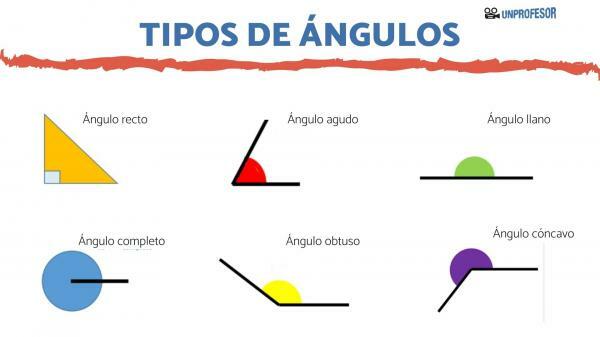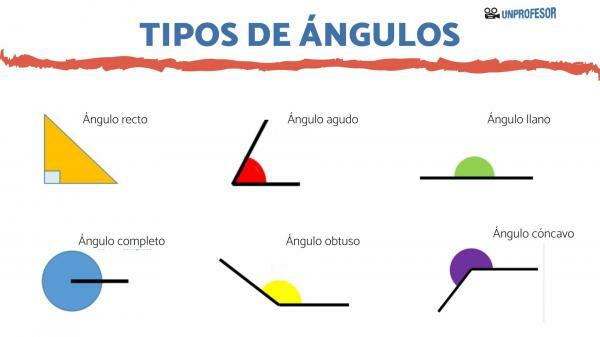ANGLE types and their characteristics (for PRIMARY)

We are happy to provide you with a new lesson from a Teacher, with elementary data to expand your knowledge in the field of mathematics. So, we will see what is understood by angle, what types of angles there are and their features and, finally, we will make a couple of small training of which we will give you the solutions below. You will surely end up understanding the angles in detail!
Index
- Types of angles
- Angle concept
- Angle types exercise
- Solution
Types of angles.
The angles can be different types, but the one that needs to be more clear is the right angle, because from its definition, we will take the others. In this way, the different angles that we can find are the following:
- Angle right: it is the one that measures exactly 90º and, to identify it, we can think of the corner of a square.
- Angle null: is the one that measures 0º and, therefore, does not have an opening, but the two lines are together, one above the other, so that there is no gap between them.
- Angle acute: it is the one that measures less than 90º, so it is more closed than a right angle.
- Angle obtuse: it is the one that measures more than 90º, so it is more open than a right angle, but less than 180º, so it is more closed than a straight angle.
- Angle flat: it is the one that measures exactly 180º and we will quickly identify it because it is a straight line.
- Angle concave: is the one that measures more than 180º, but less than 360º, so it is greater than an obtuse one, but less than the full angle.
- Angle full: it is the one that measures exactly 360º and we can compare it with the null angle, but taking the other side of the lines as a point of view. That is, instead of looking at the inside of the two lines that, remember, are one on top of the other, we will look at the outside.
In short, if we had to order the angles explained in the previous classification from lowest to highest, the list it would be this: null angle, acute angle, right angle, obtuse angle, straight angle, concave angle and, finally, angle full.
Angle concept.
An angle is the opening that is between two lines that are joined by a point called vertex. This opening can be measured in degrees or radians and the tool we recommend using for this is the protractor.
In addition, it must be taken into account that, for each pair of lines, two angles will be generated: the interior and the exterior. So the elements of an angle are both sides, both angles and the vertex.
We find angles in our daily life all the time: the corners of a goalpost form angles. football, the slices of a pizza, the lean of the tower of Pisa in Italy, the hands of a clock analogical…
Exercise of the types of angles.
So that you can check if you have understood the lesson on the different types of angles and their characteristics, then we leave you two exercises what you can do and then check the solutions in the next section.
1. Classify the following angles:
- - Angle of 20º
- - Angle of 90º
- - Angle of 150º
- - 360º angle
- - Angle of 2º
- - Angle of 95º
- - Angle of 200º
- - Angle of 359º
- - Angle of 0º
- - Angle of 180º
2. Classify the exterior and interior angles that make the hands of a clock in these hours:
- - 12:15
- - 9:15
- - 7:30
- - 8:10
- - 6:30
- - 3:50
Solution.
Let's see if you have correctly understood the types of angles explained in this article. Here you have the solutions from the previous exercise so you can check the results:
1.
- - Angle of 20º: acute.
- - Angle of 90º: straight.
- - 150º angle: obtuse.
- - 360º angle: complete.
- - Angle of 2º: acute.
- - Angle of 95º: obtuse.
- - Angle of 200º: concave.
- - Angle of 359º: concave.
- - Angle of 0º: null.
- - 180º angle: flat
2.
- - 12:15 pm: the inside is straight and the outside is concave.
- - 9:15 AM: both are flat angles.
- - 7:30 am: the inside is sharp and the outside is concave.
- - 8:10: both are flat angles.
- - 6:30: the interior is null and the exterior is complete.
- - 3:50: the inside is obtuse and the outside is concave.
As always, if you want to expand your knowledge about angles or about any aspect of the Mathematics subject, we recommend that you navigate through the tabs of our website, specifically, by that of Geometry.

If you want to read more articles similar to Types of angles, we recommend that you enter our category of Geometry.



